Battery reconditioning equipment is key to making old batteries work like new. It saves money, extends battery life, and cuts down on waste. This guide will help you pick the best equipment for personal or business use. We’ll cover lead-acid, lithium-ion, and hybrid vehicle batteries.
Whether you’re fixing batteries for yourself or starting a business, knowing your equipment is vital. We’ll explore specialized tools and advanced chargers. This guide aims to help you understand battery reconditioning and make smart choices for your batteries.
Key Takeaways
- Battery reconditioning can restore battery performance up to 95% efficiency, saving you money on new batteries.
- The process involves charging, deep discharging, and balancing the battery to break down sulfate crystals.
- Different types of batteries, including lithium-ion, lead-acid, and hybrid, require specialized equipment for reconditioning.
- Proper battery maintenance and the right equipment can prolong the lifespan of your batteries.
- Battery reconditioning is a cost-effective and environmentally friendly option compared to purchasing new batteries.
Understanding Battery Reconditioning
Battery reconditioning brings back a battery’s power and life. It uses methods like desulfation for lead-acid batteries and cell balancing for lithium-ion ones. This makes your batteries work better and last longer, saving money and the planet.
What is Battery Reconditioning?
Battery reconditioning is a way to make old or weak batteries new again. It starts with checking the battery, finding out why it’s not working, and then fixing it. Battery reconditioning tools like desulfators and cell balancers help fix lead-acid and lithium-ion batteries.
Benefits of Reconditioning Batteries
- Cost savings: It’s cheaper than buying a new battery.
- Extended battery life: It makes batteries last longer, so you don’t need to replace them as often.
- Environmental conservation: It helps reduce waste and saves energy by making batteries last longer.
Common Myths About Reconditioning
Some people think battery reconditioning doesn’t work or is dangerous. They also believe it only works for certain types of batteries. But, with the right lead-acid battery rejuvenation or lithium-ion battery revival equipment, it’s safe and effective.
“Proper reconditioning can extend the lifespan of a car battery, reducing the need for frequent replacements.”
Types of Battery Reconditioning Equipment
Choosing the right equipment is key for battery reconditioning success. You’ll find everything from multimeters to smart chargers. Knowing what each tool does helps you pick the best for your workshop.
Overview of Equipment Types
The main tools for battery reconditioning are:
- Multimeters – These devices measure voltage, current, and resistance. They’re vital for finding battery problems.
- Smart Chargers – These chargers use advanced cycles to safely recharge batteries. They help bring back a battery’s power.
- Desulfators – These tools remove sulfate buildup from battery plates. This is a common reason batteries lose power.
- Battery Load Testers – They check how well a battery can supply current. This shows its health and how much life it has left.
Specialty Tools for Different Battery Types
There are also tools for specific battery types. For instance, the EVc-30 is great for electric and hybrid car batteries. Industrial battery reconditioners need special gear for big, heavy-duty batteries in forklifts and golf carts.
Battery Maintainers vs. Reconditioners
It’s crucial to know the difference between battery maintainers and battery reconditioners. Maintainers keep batteries healthy by charging them gently. Reconditioners are stronger and can fix badly damaged batteries. The right tool depends on your business needs and the batteries you work on.

Key Features to Look For
When choosing battery reconditioning equipment, several key features are crucial. Voltage compatibility is key, as you need a device that fits the voltage needs of your batteries. This includes lead-acid, lithium-ion, and nickel-cadmium types. The battery reconditioning process often involves menu-driven charge-discharge cycling and software for analyzing amp-hour capacity. This can greatly help in restoring your batteries.
Capacity and Power Ratings
The capacity and power ratings of the equipment are also vital. You need a device that can handle the power needs of commercial battery reconditioning systems. Look for adjustable current and voltage settings. Also, ensure it can handle various battery sizes and types.
Safety Features to Consider
Safety is a top priority in battery reconditioning. Look for equipment with strong safety features. These include overcharge protection, temperature monitoring, and automatic shut-off. These features help prevent accidents and ensure your batteries and equipment last longer.
“The EVc-30, for instance, offers menu-driven charge-discharge cycling and software for analyzing amp-hour capacity, making it a valuable tool in the battery reconditioning process.”
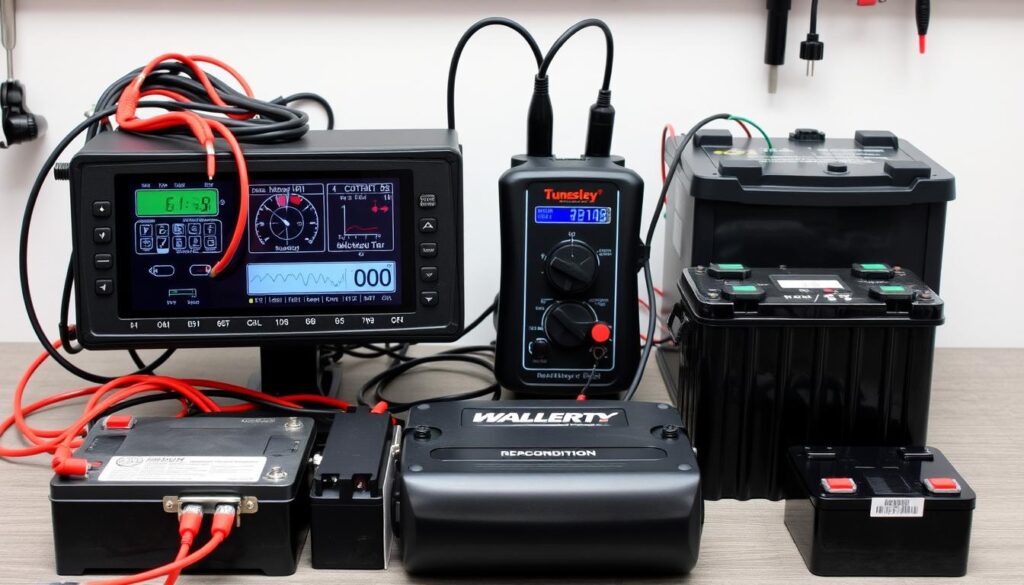
By choosing equipment that meets these criteria, you can confidently recondition batteries. This saves money and helps the environment by reducing waste.
Supplier and Brand Research
Looking into top brands and reliable suppliers is key for professional battery rebuilding gear and industrial battery reconditioners. It helps you choose the best equipment for your needs. This way, you invest in quality that lasts.
Top Brands in Battery Reconditioning
Leading brands in battery reconditioning include NuVant Systems with the EVc-30 tool. Other big names are Midtronics, Battery Mechanic, and Batteryminden. They all have specialized tools for different battery types.
Evaluating Supplier Reputation
When picking a supplier, look at their product quality, support, and training. Good suppliers offer top-notch gear and great service after you buy. Check their reputation, certifications, and customer feedback.
Importance of Customer Reviews
Customer reviews offer real insights into battery reconditioning equipment. They talk about ease of use, durability, and satisfaction. These reviews can show you the good and bad of a brand or model, helping you decide.
Researching brands, checking supplier reputations, and reading customer reviews are crucial. They help you choose the right equipment for your needs. This ensures you get gear that works well and lasts long.
Budgeting for Equipment
Investing in quality battery reconditioning tools and battery restoration kits is key for successful battery revitalization. When setting your budget, think about the initial costs and the long-term expenses. Also, consider the potential return on investment (ROI).
Setting a Realistic Budget
First, decide your budget based on your needs and the size of your operation. Include the cost of equipment, software, and any training or certification. Remember, high-quality equipment might cost more upfront. But it often offers better long-term value and performance.
Cost vs. Quality Considerations
It’s tempting to choose the cheapest battery reconditioning tools or battery restoration kits. But, it’s important to balance cost with quality and features. Investing in durable, reliable tools can save money in the long run. It reduces maintenance, improves efficiency, and extends battery life.
Additional Costs to Factor In
- Ongoing maintenance and repairs
- Software updates and subscription fees
- Specialized accessories or attachments
- Training for your team on proper equipment usage
- Potential impact on labor costs and productivity
By considering these factors, you can create a detailed budget. It balances the initial investment with the long-term value and ROI of your equipment.
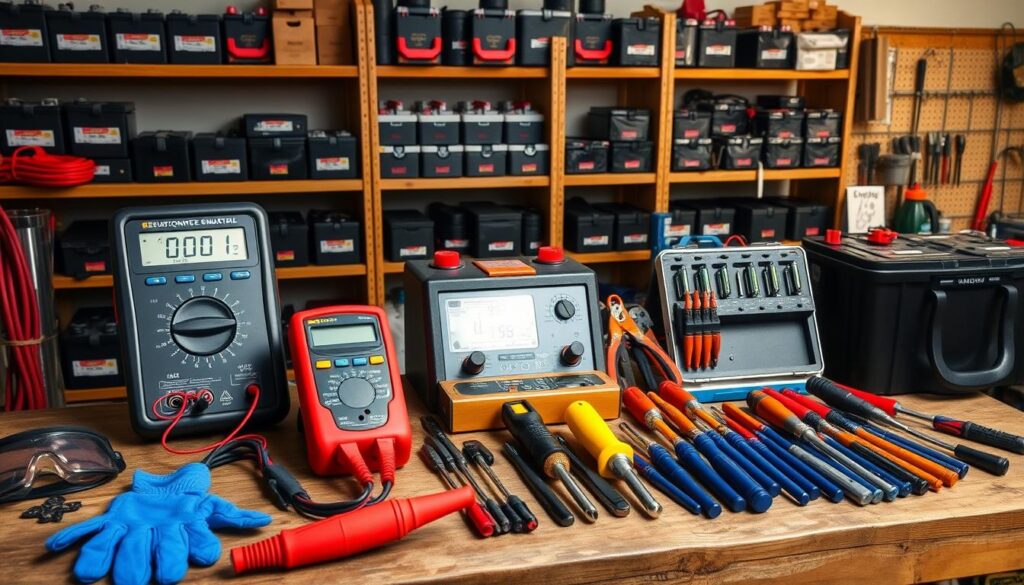
Where to Buy Battery Reconditioning Equipment
Looking for battery remanufacturing machines or commercial battery reconditioning systems? You have many places to check. You can look online, visit local stores, or even go to trade shows. Your choice will depend on what you need and like.
Online Retailers vs. Local Stores
Online stores have a big selection of battery reconditioning gear. You can compare prices and features from home. Companies like NuVant Systems offer training and software to help you use your equipment well.
Local stores, however, let you see and touch the equipment before buying. They also offer help and advice from people who know the products.
Auctions and Refurbished Options
Want to save money? Try auctions or refurbished equipment. Auctions, online or in-person, have used battery remanufacturing machines and commercial battery reconditioning systems at lower prices. Refurbished gear can also be a good deal if you check the supplier well.
Trade Shows and Expos
Trade shows and expos are great for seeing the newest battery remanufacturing machines and commercial battery reconditioning systems. You can watch live demos and talk to makers and sellers. It’s a chance to compare and choose wisely.
Choosing where to buy depends on your budget, time, and needs. Researching and considering your options will help you find the best fit for your business and extend battery life.
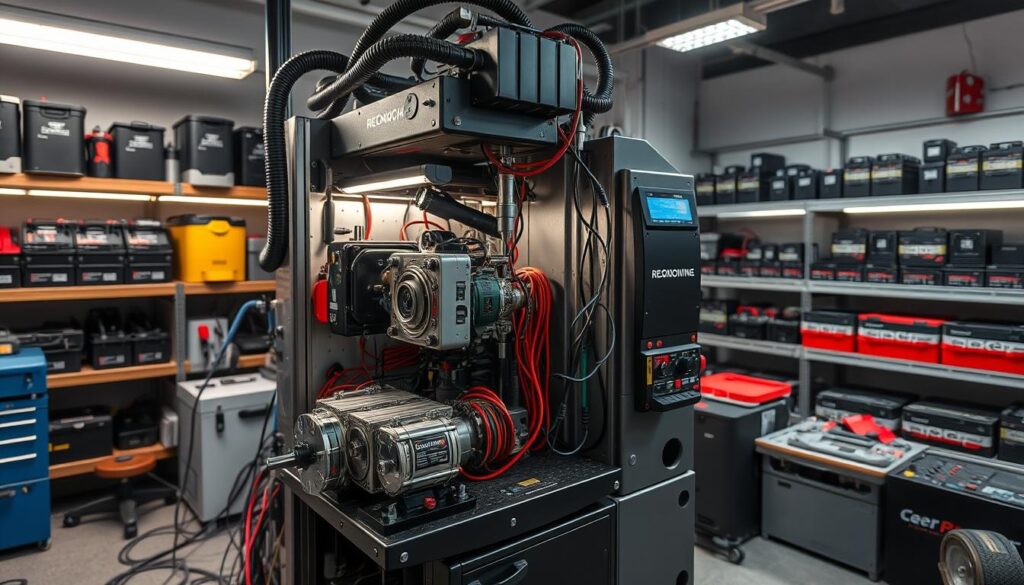
Understanding Warranty and Support
When you buy professional battery rebuilding gear or tools, think about the warranty and support. A good warranty can make you feel secure and protect your money.
Importance of Warranty Coverage
Find suppliers with strong warranties, like SolaX Power, which has a top score of 16. Their warranties last from 10 to 20 years. They promise to keep your battery working at about 70% at the end.
Other brands, like Panasonic and FranklinWH, offer 12 to 13 years of warranty. Villara Energy Systems provides 11 years.
What to Expect from Customer Support
Good customer support is key when using battery reconditioning tools. Look for companies like NuVant Systems. They offer help, maintenance tips, and training webinars.
This support can help you get the most out of your tools.
Repair and Maintenance Assistance
Choose suppliers that help with repairs and maintenance. Some, like SolaX Power and FranklinWH, cover all labor costs. Others might pay for shipping or a certain amount of work.
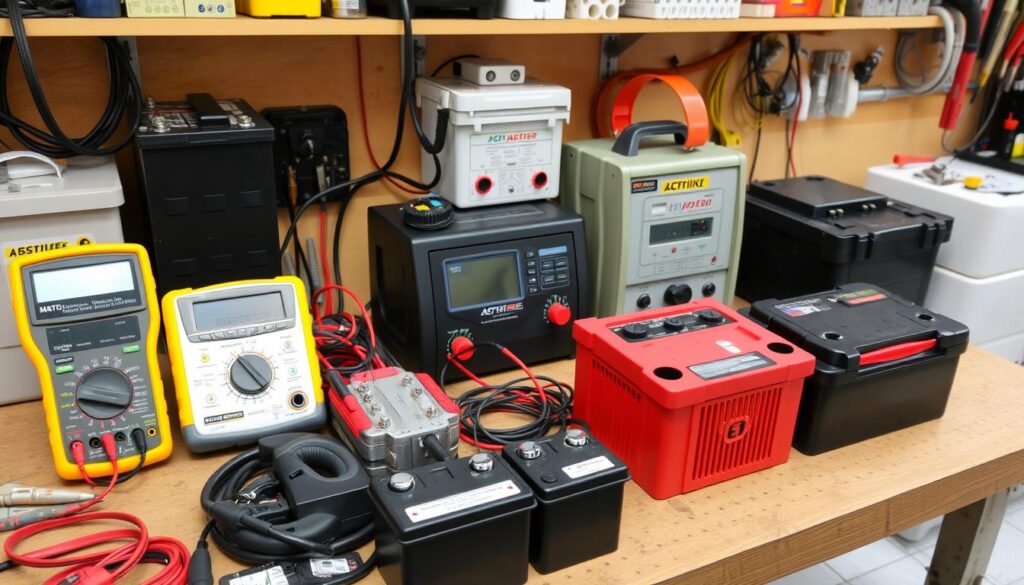
Knowing about warranty and support from your supplier is important. It ensures your investment in battery tools is safe and supported for years.
Reading Product Specifications
When looking for battery reconditioning equipment, it’s key to read the product specs carefully. This ensures you make a smart choice. The technical details might seem complex, but knowing them helps find the perfect battery reconditioning process or lithium-ion battery revival equipment for you.
Decoding Technical Specifications
Look for the voltage range the equipment can handle. Also, check its charging and discharging abilities. Make sure it works with different battery types. The wrong voltage can harm the battery or the device.
Understanding Performance Metrics
Check the reconditioning speed and how well it balances cells. Also, look at data analysis tools. Faster and more accurate reconditioning saves time. Advanced data tools give insights into battery health.
Comparing Products Effectively
When comparing battery reconditioning process and lithium-ion battery revival equipment, consider specs and performance. Also, think about the price and brand reputation. A more expensive item might have better features, but check if it fits your needs and budget.
| Specification | Product A | Product B | Product C |
|---|---|---|---|
| Voltage Range | 6V – 24V | 12V – 48V | 6V – 36V |
| Charging/Discharging Capabilities | 2A charging, 1A discharging | 5A charging, 3A discharging | 3A charging, 2A discharging |
| Battery Compatibility | Lead-acid, Lithium-ion | Lead-acid, Lithium-ion, Nickel-Cadmium | Lead-acid, Lithium-ion, Nickel-Metal Hydride |
| Reconditioning Speed | 30 minutes per battery | 15 minutes per battery | 20 minutes per battery |
| Cell Balancing Accuracy | ±0.1V | ±0.05V | ±0.07V |
| Data Analysis Capabilities | Basic | Advanced | Intermediate |
Understanding specs and performance helps you choose the right battery reconditioning process or lithium-ion battery revival equipment for your needs and budget.
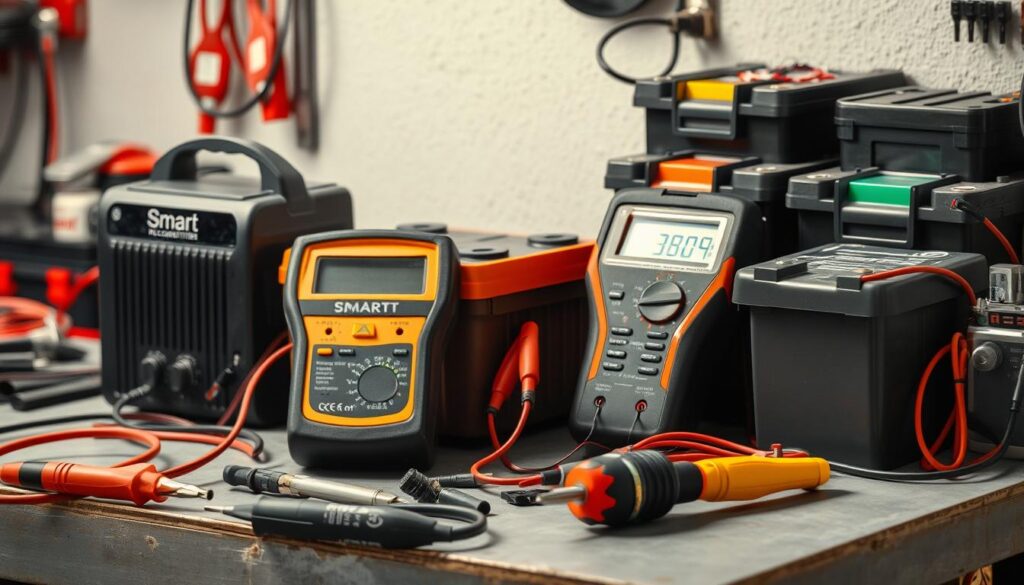
The Buying Process
Buying battery reconditioning equipment requires careful research and decision-making. As an industrial battery reconditioner, it’s important to make the right choice. This ensures you get the equipment that fits your needs and budget.
Step-by-Step Guide to Purchase
- Identify your battery reconditioning requirements: Know the types of batteries you’ll work with and how much you’ll need to recondition.
- Research and compare equipment options: Look at different types of equipment, their features, and prices.
- Evaluate supplier reputation and customer reviews: Check the reputation of suppliers and what customers say about them.
- Obtain quotes and negotiate pricing: Ask suppliers for quotes and try to get the best deal.
- Verify compatibility and safety features: Make sure the equipment works with your batteries and has safety features.
- Make the purchase and complete the setup: Buy the equipment and set it up as the manufacturer instructs.
Common Pitfalls to Avoid
- Overlooking compatibility issues: Make sure the equipment fits your battery types to avoid mistakes.
- Underestimating training requirements: Don’t forget to plan for training your team on the equipment.
- Disregarding maintenance and support: Remember the importance of warranty, repair, and maintenance services.
Post-Purchase Considerations
After buying your equipment, focus on these important steps:
- Proper setup and initial training: Make sure the equipment is set up right and your team knows how to use it.
- Integrating the equipment into your workflow: Add the new equipment smoothly to your current processes to improve efficiency.
- Maintaining the equipment for longevity: Follow the manufacturer’s maintenance advice to keep your equipment in good shape.
By carefully going through the buying process, you can make a smart choice. This choice will help your industrial battery reconditioning business succeed in the long run.
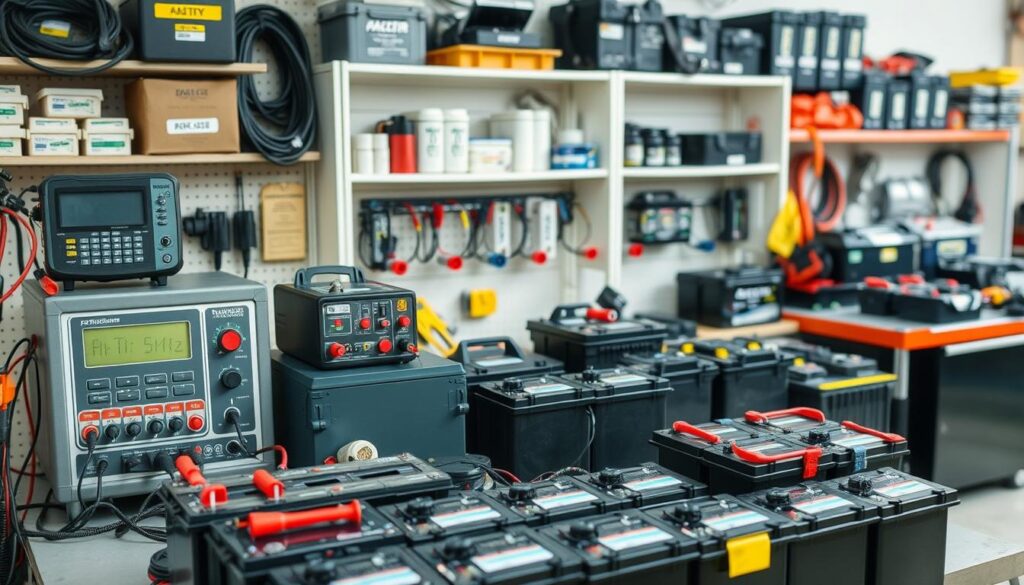
Setting Up Your Equipment
Starting your battery reconditioning journey means setting up your gear right. Whether you’ve bought tools or kits, the setup is key for good performance and safety. Let’s look at the important steps to get your equipment ready.
Initial Setup Tips
First, read the instructions from the maker. They’ll show you how to install, calibrate, and use your tools. It’s important to know the settings, controls, and functions to use your tools well.
Safety Precautions to Take
Working with batteries is risky, so safety comes first. Make sure your area is well-ventilated. Always wear safety goggles, gloves, and a mask. Follow the maker’s instructions closely, as they’ve made their tools safe.
Essential Accessories You Might Need
You might need special accessories with your tools. These could be:
- Special connectors and adapters for different batteries
- Safety gear like fire extinguishers and spill kits
- Software to check battery performance
With the right accessories, you can handle more battery tasks with ease and skill.
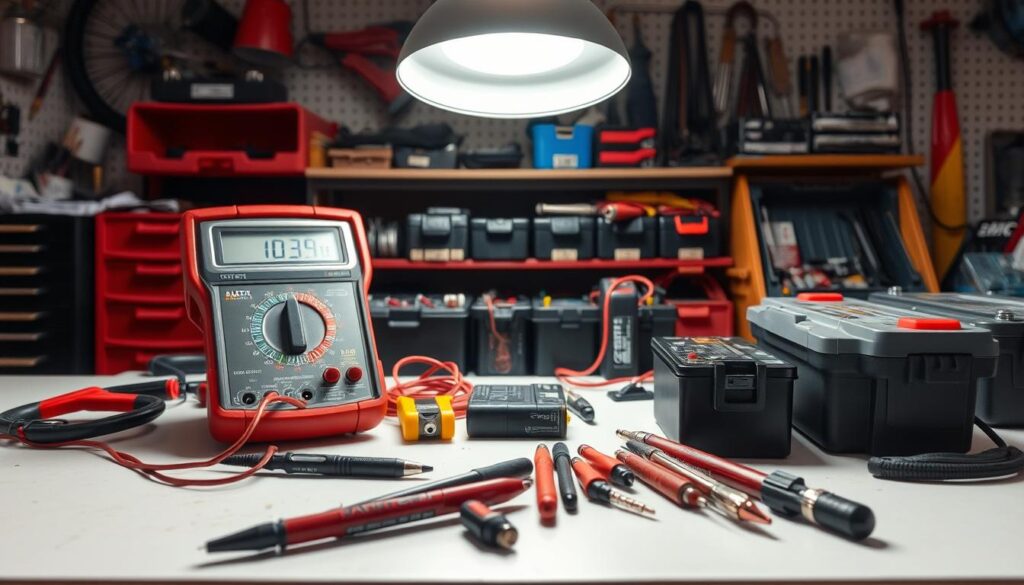
Setting up right and being safe is the base for good battery reconditioning. Take time to learn your equipment. If you have questions, ask the maker or experts. With the right steps, you’ll be able to make old batteries work again.
Maintenance for Longevity
Keeping your professional battery rebuilding gear and machines in top shape is key. Regular cleaning and software updates are crucial. This way, your equipment lasts longer and works better, saving you money and time.
Routine Maintenance Practices
Start by cleaning your gear often. This removes dust, debris, and corrosion. Cleaning also makes your equipment look good and prevents problems.
Don’t forget about software updates. They fix bugs and make your machines work better. This boosts your battery reconditioning efficiency.
Calibration checks are also important. Make sure your equipment’s readings are correct. This ensures your battery reconditioning is reliable and consistent.
Troubleshooting Common Issues
Even with good maintenance, you might still face technical issues. Problems can include software glitches, charging issues, or connectivity problems. If you run into these, check your equipment’s guide or contact the manufacturer’s support.
When to Seek Professional Help
For big problems or if your equipment isn’t working well, get help from pros. They have the skills and tools to fix complex issues. This keeps your battery reconditioning smooth and reliable.
| Maintenance Recommendation | Frequency | Benefits |
|---|---|---|
| Cleaning and Inspection | Monthly | Prevents malfunctions, extends equipment lifespan |
| Software Updates | Quarterly | Addresses bugs, improves performance |
| Calibration Checks | Quarterly | Ensures accurate readings and consistent results |
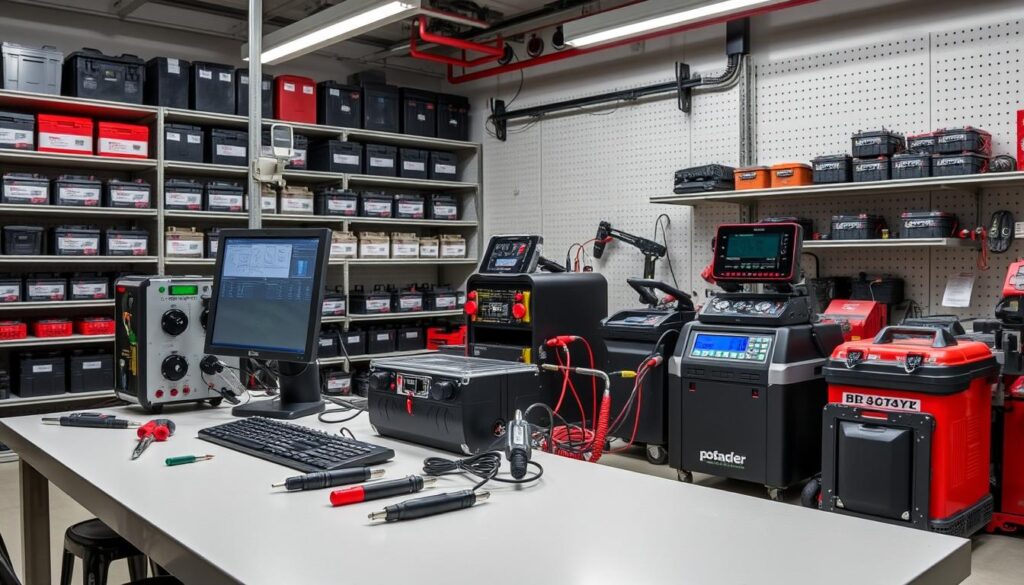
“Proper maintenance is the key to getting the most out of your battery reconditioning equipment. By following a proactive approach, you can extend the lifespan of your investment and maintain optimal performance.”
Advanced Techniques in Battery Reconditioning
Battery technology keeps getting better, and so do the ways to fix old batteries. New methods like pulse reconditioning for lead-acid batteries and cell balancing for lithium-ion batteries are changing the game. These advanced techniques can make your old batteries work like new again.
Innovations in Battery Technology
Pulse reconditioning uses electrical pulses to clear out sulfate crystals in lead-acid batteries. This method can make batteries last longer and work better. For lithium-ion batteries, cell balancing keeps each cell charged right, preventing them from wearing out too soon.
DIY vs. Professional Reconditioning
DIY battery fixing can save money, but pros often do a better job. They have special tools and know-how that DIY folks might not. Still, learning to fix batteries yourself can be rewarding and save you cash.
Trends in Sustainable Practices
The battery fixing world is going green. More focus on recycling batteries and promoting a circular economy is helping the planet. By fixing batteries instead of throwing them away, we can all help the environment and support a sustainable future.
FAQ
What is battery reconditioning and how does it work?
Battery reconditioning makes old batteries work like new again. It uses methods like desulfation for lead-acid batteries and cell balancing for lithium-ion ones.
What are the benefits of battery reconditioning?
Reconditioning saves money and extends battery life. It also cuts down on waste by reviving old batteries instead of throwing them away.
What are some common myths about battery reconditioning?
Some people think it’s not effective or safe. But, done right, it’s a reliable and affordable way to fix batteries.
What types of battery reconditioning equipment are available?
You’ll need multimeters, smart chargers, desulfators, and tools for different batteries. The EVc-30 is a special tool for hybrid batteries.
What key features should I look for in battery reconditioning equipment?
Look for voltage match, enough capacity and power, and safety features like overcharge protection and temperature checks.
Which are the top brands in battery reconditioning equipment?
Top brands include NuVant Systems. They make the EVc-30 tool for fixing hybrid batteries.
How do I budget for battery reconditioning equipment?
Consider the cost of equipment, maintenance, and potential savings. Better equipment might cost more upfront but saves money in the long run.
Where can I purchase battery reconditioning equipment?
Buy online from specialized stores, local shops, or directly from makers. Trade shows let you see equipment and compare.
What kind of warranty and support should I expect with battery reconditioning equipment?
Choose suppliers with good warranties, customer support, and training. This helps you use the equipment well.
How do I properly set up and maintain my battery reconditioning equipment?
Set it up by installing, calibrating, and learning its features. Keep it clean, update software, and check calibration. For tough issues, get professional help.
Source Links
- Beginners Guide To Understand Battery Reconditioning.
- 8 Ways To New Battery Reconditioning Course Review Without Breaking Your Bank | 匡腾EHS信息化管理系统
- What is Battery Reconditioning In A Hybrid Car?
- What You Should Know About Battery Reconditioning
- 5-Step Ultimate Guide to Successful Car Battery Reconditioning – VoltifyHub.com
- What is a Battery – A Complete Guide to Battery Basics
- Best Car Battery Buying Guide – Consumer Reports
- # Car Battery Reconditioning: Revive Your Battery Life Today!
- Unlock the Power of Hybrid Battery Reconditioning: Your Guide to Self-Service and Repair for Hybrid Owners
- What is a Battery – A Complete Guide to Battery Basics
- Comprehensive Buying Guide for Lithium Battery Solutions
- The ultimate guide to the EV battery supply chain
- The Ultimate Guide to LANPWR 12V 100Ah Battery
- Jump Start Your Savings: A Comprehensive Guide to Choosing the Best Car Jump Starter
- The Ultimate Buying Guide for Tubular Batteries: Durability, Costs, and Performance
- Hybrid Battery Reconditioning Guide | Nuvant Systems Inc.
- Battery warranties: What to know
- 12 Volt Battery Guide: Everything You Need to Know
- What is a Battery – A Complete Guide to Battery Basics
- The Ultimate EZ Battery Reconditioning System Review 2020
- What is a Battery – A Complete Guide to Battery Basics
- How To Recondition A Car Battery In 5 Easy Steps
- How to Recondition a Car Battery at Home?
- What is Battery Reconditioning In A Hybrid Car?
- Best Practices for Battery Selection and Installation | Carter Machinery
- EZ Battery Reconditioning PDF Free Download
- Trojan Battery | Battery Maintenance
- What is a Battery – A Complete Guide to Battery Basics
- What is a Battery – A Complete Guide to Battery Basics
- How To Recondition A Car Battery That Won’t Hold Charge?
- ()How to Recondition a Laptop Battery: Ultimate DIY Guide!
